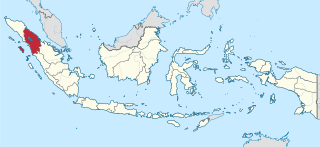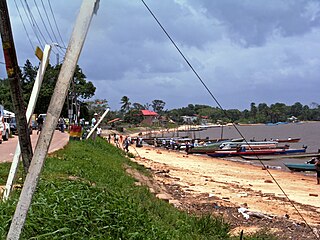The early history of Suriname dates from 3000 BCE when Native Americans first inhabited the area. The Dutch acquired Suriname from the English, and European settlement in any numbers dates from the 17th century, when it was a plantation colony utilizing slavery for sugar cultivation. With abolition in the late 19th century, planters sought labor from China, Madeira, India, and Indonesia, which was also colonized by the Dutch. Dutch is Suriname's official language. Owing to its diverse population, it has also developed a creole language, Sranan Tongo.

Javanese is a Malayo-Polynesian language spoken by the Javanese people from the central and eastern parts of the island of Java, Indonesia. There are also pockets of Javanese speakers on the northern coast of western Java. It is the native language of more than 98 million people.

Indonesian cuisine is a collection of various regional culinary traditions that formed in the archipelagic nation of Indonesia. There are a wide variety of recipes and cuisines in part because Indonesia is composed of approximately 6,000 populated islands of the total 17,508 in the world's largest archipelago, with more than 1,300 ethnic groups.

North Sumatra is a province of Indonesia located on the northern part of the island of Sumatra. Its capital and largest city is Medan. It is bordered by Aceh on the northwest and Riau and West Sumatra in the southeast, with two different coastlines located on the Indian Ocean and the Strait of Malacca, and a maritime border with Malaysia to the east. North Sumatra is Indonesia's fourth most populous province after West Java, East Java and Central Java, and the third-largest province on the island of Sumatra after the neighbouring Riau. It covers an area of 72,981 km2.It is approximately the same size of Sierra Leone. According to the 2020 census, the province's population in that year was 14,799,361. The mid-2022 official estimate was 15,115,206. North Sumatra is a multi-ethnic province. The Malay people are regarded as the natives of the east coast of the province, while the west coast of the province is mainly inhabited by the Batak. The central highlands region around Lake Toba is predominantly inhabited by other Batak groups. The Nias people are natives to Nias Island and its surrounding islets. With the opening of tobacco plantations in East Sumatra during the colonial era, the colonial government employed many contract labourers for plantations, mainly Chinese, Javanese and Indian migrants. The majority did not return after their contract ended and decided to stay in the province. The recent rapid urbanisation also attracted neighbouring people from Aceh, Riau and West Sumatra.

South Sumatra is a province of Indonesia, located in the southeast of the island of Sumatra. The capital and largest city of the province is the city of Palembang. The province borders the provinces of Jambi to the north, Bengkulu to the west and Lampung to the south, as well a maritime border with the Bangka Belitung Islands to the east. It is the largest province in the island of Sumatra, and it is slightly smaller than Portugal. The Bangka Strait in the east separates South Sumatra and the island of Bangka, which is part of the Bangka Belitung Islands province. The province has an area of 91,592.43 km2 (35,364 sq mi) and had a population of 8,467,432 at the 2020 Census; the official estimate as at mid-2022 was 8,657,008. The province is rich in natural resources, such as petroleum, natural gas and coal. The province is inhabited by many different ethnic groups, with Palembangese being largest ethnic group. Most speak the Palembang language, which is mutually intelligible to both Indonesian and local Palembang Malay. Other ethnic groups include the Javanese, Sundanese, Minangkabau and Chinese. Most are concentrated in urban areas and are largely immigrants from other parts of Indonesia.

Lampung, officially the Province of Lampung, is a province of Indonesia. It is located on the southern tip of the island of Sumatra. It has a short border with the province of Bengkulu to the northwest, and a longer border with the province of South Sumatra to the north, as well a maritime border with the province of Banten and Jakarta to the east. It is the original home of the Lampung people, who speak their own language, and possess their own written script. Its capital is Bandar Lampung.
The transmigration program was an initiative of the Dutch colonial government and later continued by the Indonesian government to move landless people from densely populated areas of Indonesia to less populous areas of the country. This involved moving people permanently from the island of Java, but also to a lesser extent from Bali and Madura to less densely populated areas including Kalimantan, Sumatra, Sulawesi, Maluku and Papua. The program is currently coordinated by Ministry of Villages, Development of Disadvantaged Regions, and Transmigration.

Marowijne is a district of Suriname, located on the north-east coast. Marowijne's capital city is Albina, with other towns including Moengo and Wanhatti. The district borders the Atlantic Ocean to the north, French Guiana to the east, the Surinamese district of Sipaliwini to the south, and the Surinamese districts of Commewijne and Para to the west.
The Jungle Commando was a guerrilla commando group in Suriname. It was founded by Ronnie Brunswijk in 1986 to ensure equal rights for Suriname's minority Maroon population. The group was formed after the Suriname troops committed mass murder against 35 people in Moiwana Village, near Moengo, after the Suriname national army failed to capture Ronnie Brunswijk. The Commando fought against Dési Bouterse and the Surinamese army in the Suriname Guerrilla War.

Moengo is a town in Suriname, located in the Marowijne district, between Paramaribo and the border town Albina on the Cottica River. Moengo is also a resort (municipality) in the district of Marowijne. Moengo was the capital of Marowijne District between 1932 and 1945. The current capital is Albina.
Javanese Surinamese are an ethnic group of Javanese descent in Suriname. They have been present since the late 19th century, when their first members were selected as indentured laborers by the Dutch colonizers from the former Dutch East Indies.

Surinam, also unofficially known as Dutch Guiana, was a Dutch plantation colony in the Guianas, bordered by the equally Dutch colony of Berbice to the west, and the French colony of Cayenne to the east. It later bordered British Guiana from 1831 to 1966.

William Soemita was a Surinamese parliamentarian and minister. He was the only Deputy Vice President of Suriname, serving from 1988 to 1990.
The Brooskampers were a Maroon people, descendants of runaway African slaves, living in the forested interior of Suriname. The tribe is related to the Saramaka, and originated from Loango-Angola. The Brooskampers gained autonomy in 1863, but sold their land in 1917.

The Javanese diaspora is the demographic group of descendants of ethnic Javanese who emigrated from the Indonesian island of Java to other parts of the world. The Javanese diaspora includes a significant population in Suriname, with over 13% of the country's population being of Javanese ancestry. Other major enclaves are found in Australia, French Guiana, Malaysia, the Netherlands, New Caledonia, Singapore, South Africa, and Sri Lanka.

Dance in Suriname is practiced from the amateur to the professional level for cultural, social and spiritual reasons, among others. Suriname has a variety of traditional and contemporary dance styles which have developed from the cultures of its ethnic groups. In addition, several foreign popular styles have been adopted from the West, the greater Caribbean, Java and Bollywood.

Onverdacht is a village in the resort of Zuid in the Para District of Suriname. Between 1941 and 2009, it was a bauxite mining town.

The Central Advisory Council was the name given to bodies established by the Japanese military administration in Java and Sumatra in 1943 during the Japanese occupation of the Dutch East Indies to notionally provide Indonesians with popular representation.













